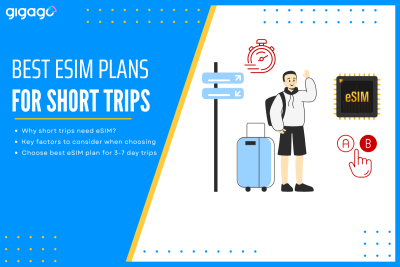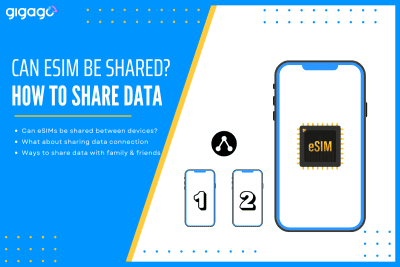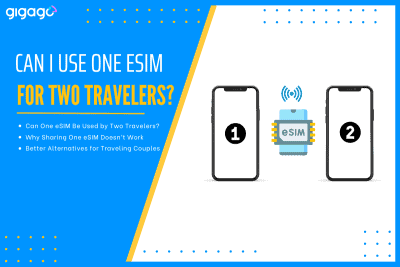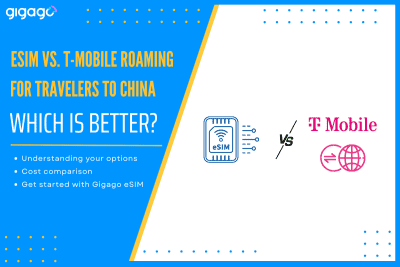Traveling for a short trip, typically for 3- to 7-days, drastically changes the rules of connectivity. The traditional solutions like expensive carrier roaming or time-consuming local SIM buying are simply impractical when time time is precious. This is where eSIMs take the picture. The eSIM (embedded because it is a digital solution that solves the […]
How to Switch eSIM Profiles Between International Trips
If you land in a foreign country, are ready to explore, but your phone does not connect, or you have to cope with exorbitant roaming charges, switching to a local network will solve it. Using eSIM technology will help you get it while avoiding wasting time hunting for a SIM card. With eSIM technology, you can effortlessly switch between profiles in seconds, ensuring instant connectivity and no hassle. This article will show you how to switch eSIM profiles between international trips, saving you time, money, and stress on your trips.

In this article
I. What are eSIM profiles and benefits for international travel?
What are eSIM profiles?
eSIM profiles are the digital counterparts of traditional SIM cards. Unlike physical SIMs, eSIM profiles store carrier information, network settings, and subscription plans directly on your device. This allows you to download, activate, and manage multiple profiles without the need to swap physical cards, making them a game-changer for international travelers.
Benefits of using eSIM profiles for international travel
- Enhanced connectivity: You can easily switch to a local network for stronger signals and better coverage.
- Cost Savings: Multiple eSIM profile users can avoid costly roaming charges by using local or regional eSIM plans.
- Remote Management: Manage and activate eSIM profiles directly from your device settings – no physical swaps or store visits required.
II. How to prepare eSIMs for your international trip?
Proper preparation is key to making the most of your eSIM profile while traveling abroad.
1. Check device compatibility
You need to confirm that your device supports eSIM technology and is unlocked for use with multiple carriers internationally.
See an updated list of popular eSIM-compatible devices here.
To verify, you can check your device’s specifications or visit the manufacturer’s website.
2. Choose the right eSIM provider
Selecting the right eSIM provider is crucial for getting reliable service and value for money. You should consider these factors when choosing an eSIM provider:
- Ensure the provider offers strong network coverage in your destination country.
- Choose the provider for high speed data plans
- Compare prices per GB and look for discounts or loyalty programs.
The top providers of travel eSIM are Gigago, Ubigi, Nomad, Holafly.
3. Buy and install your eSIM
eSIM installation is quick and simple. You can do it via scanning a QR code provided by your eSIM provider (the easiest), or app integration (depending on the provider), or manual entry through your device settings (less common).
4. Organize and Name Your eSIM Profiles
If you plan to use multiple eSIM profiles, name each profile clearly based on the country or provider (e.g., “Japan – Gigago”). This will make it easier to switch profiles during your trip.
III. How to switch eSIM profiles between international trips
Here is how you can efficiently switch eSIM profiles on both iPhone and Android devices.
1. Switching eSIM profiles on iPhone
- Go to Settings > Cellular / Mobile data Under the SIMs section, you will see a list of eSIM profiles
- Choose the want you want to use > select Turn on this line
- Then set the active eSIM as your default for mobile data
- Deactivate any inactive profiles to avoid potential conflicts
Pro Tip: Name your profiles (e.g., “France – Gigago”) so you can easily identify them when switching.
2. Switch eSIM profiles on Android
The process of switching eSIM profiles on Android devices may vary slightly depending on the phone model, but here’s a general guide:
- Go to Settings > Connections > SIM Manager (or Network & Internet > SIM cards on other devices)
- Select the eSIM profile you want to use > activate it
- Assign the role for active eSIM (as Mobile data source, calls, etc.
Pro Tip: You can keep one eSIM active for calls/messages (e.g., your home eSIM) while using a travel eSIM for mobile data.
IV. How to manage eSIM profiles during international travel
If you travel frequently, you may get confused when managing multiple eSIM profiles. Here are some tips to make the process easier:
- Rename eSIM profiles based on the provider or destination to avoid confusion when switching. For example, Japan – Gigago, Work – DTAC.
- Turn off any inactive profiles to prevent unnecessary network conflicts or data usage.
- Use eSIM provider apps or widgets to track data usage and validity.
- Save a copy of your QR code in case you need to reinstall it (though some eSIM providers only allow for eSIM installation once.)
- Switch before landing at your new destination to avoid delays in connectivity.
- Monitor your data usage to save costs. Use the built-in features on your phone in the Settings menu or the tools provided in your eSIM provider’s app, such as real-time data usage tracking and balance updates. You can also use offline tools, like maps, to avoid exceeding your data limit.
- In some areas, the network associated with your active eSIM profile may have weak coverage. In such case, switching to another eSIM profile can help you stay connected or provide better coverage.
Pro Tip: Set up usage alerts on your device or within the provider’s app to prevent unexpected overage charges.
V. How to troubleshoot common eSIM issues while traveling abroad
1. Connectivity problems
To solve this problem, you first need to check network settings to ensure the active eSIM profile set as the default for mobile data, then manually choose a stronger network through your device’s network settings. If none works, restart your device.
2. Switching delays
When there are switching delays, you should wait for a few minutes, even up to 30 minutes (activating time varies by phone model). If the new eSIM does not work, turn airplane mode on and off.
When delays persist, contact your eSIM provider for support. Do not delete the eSIM and reinstall without their consultation.
3. Provider coverage gaps
If there are coverage gaps, you can switch to another profile, or use WiFi hotspots instead. If issues persist, contact your eSIM provider for assistance.



